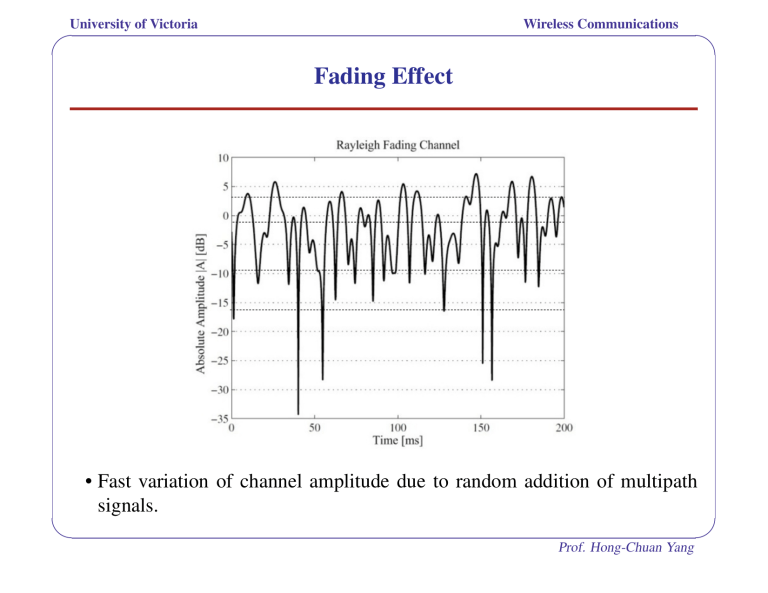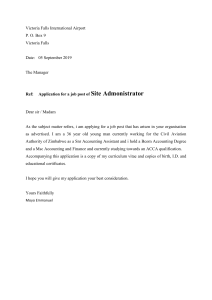
University of Victoria Wireless Communications ' $ Fading Effect • Fast variation of channel amplitude due to random addition of multipath signals. & % Prof. Hong-Chuan Yang University of Victoria Wireless Communications ' $ Diversity Techniques • Effective fading mitigation technique. • Transmit/receive the same information signal over channels experiencing independent fading. • Combine signal from different channels properly before detection. Independent channels are less likely have poor quality simultaneously. • How to create independent channels – Use different frequency bands, separated by coherence bandwidth Bc, – Use different transmission time slots, separated by coherence time Tc. – Use different resolvable paths, as in spread spectrum (CDMA) systems. – Use spatially separated (usually about half a wavelength) antennas – Explore different user channels, polarization, etc. & % Prof. Hong-Chuan Yang University of Victoria Wireless Communications ' $ Diversity Combining • Focus on antenna reception diversity here. • Assume slow frequency-flat fading channel between transmit antenna and each receive antenna. • Complex channel gain corresponding to ith receive antenna: zi = aiejθi . Es are independent. • Received SNR at ith antenna γi = |zi|2 N 0 • Performance depends on combiner output SNR, denoted by γc. • Focus on selection combining (SC) and maximal ratio combining (MRC) schemes. & % Prof. Hong-Chuan Yang University of Victoria Wireless Communications ' $ Selection Combining • Select the antenna branch with largest receive SNR. • Combiner output SNR with SC γc = max[γ1, γ2, · · · , γL], where γi is the instantaneous SNR of the ith antenna branch. • Performance analysis requires the distribution function of γc. & % Prof. Hong-Chuan Yang University of Victoria ' Wireless Communications $ Example: Outage Probability with SC Consider a digital wireless transmission system using BPSK modulation scheme. To satisfy the instantaneous BER requirement of 10−3, the received SNR should be at least 7 dB for BPSK. An L-branch selection combiner is implemented at the receiver to combat the fading effect. The channel introduces i.i.d. Rayleigh fading with average received SNR of 15 dB on each antenna branch. Determine the outage probability for L = 1, 2, and 3 cases. & % Prof. Hong-Chuan Yang University of Victoria Wireless Communications ' $ SC Performance Analysis • Average BER: integrate instantaneous BER over the distribution of γc Z ∞ Pb = Pb(γ)pγc (γ)dγ. 0 • Over independent identical (i.i.d.) Rayleigh fading channels, pγc (γ) = L [1 − e−γ/γ ]L−1e−γ/γ , γ where γ is the common average SNR. • Structure of L-branch SC combiner & % Prof. Hong-Chuan Yang University of Victoria ' Wireless Communications $ Bit Error Performance of L-branch SC for DPSK & % Prof. Hong-Chuan Yang University of Victoria ' Wireless Communications $ Maximal Ratio Combining (MRC) • Optimal linear combining scheme in noise limited environment. • Maximize the SNR of combiner output signal with optimal wi’s. & % Prof. Hong-Chuan Yang University of Victoria Wireless Communications ' $ SNR Maximization • Signal received on the ith antenna branch ri(t) = aiejθi s(t) + ni(t), i = 1, 2, · · · , L. • Combiner output as weighted sum of ri(t) rc(t) = L X wiri(t) = i=1 L X wiaiejθi s(t) + i=1 L X wini(t). i=1 • SNR of combined signal γc γc = | PL jθi 2 w · a e | Es i i i=1 . PL 2 i=1 |wi | N0 • Optimal weights wi wi ∝ aie−jθi =⇒ γc = & L X Eb i=1 N0 |hi|2 = L X γi . i=1 % Prof. Hong-Chuan Yang University of Victoria Wireless Communications ' $ Structure of MRC Combiner • Requires the complete knowledge of all diversity branches. • Processes the received signal from all branches. & % Prof. Hong-Chuan Yang University of Victoria Wireless Communications ' $ Performance Gain • PDF of γc with MRC over i.i.d. Rayleigh fading γ L−1e−γ/γ pγc (γ) = L . γ (L − 1)! & % Prof. Hong-Chuan Yang University of Victoria Wireless Communications ' $ Tradeoff Analysis L X γi > max[γ1, γ2, · · · , γL]. i=1 • MRC achieve better performance than SC, but with higher complexity – MRC requires the complete knowledge of each channel whereas SC needs only the channel amplitudes. – MRC performs linear operation on signal received on all channels while SC only processes the best one. • Threshold combining has even lower complexity than SC. • Equal gain combining (EGC) is slightly simpler than MRC. Tradeoff of performance versus complexity! & % Prof. Hong-Chuan Yang University of Victoria Wireless Communications ' $ Performance Comparison 0 10 SSC SEC SC MRC −1 10 L=2 Average Error Probability −2 10 −3 10 L=4 −4 10 −5 10 −6 10 0 5 10 15 20 Average SNR per Branch, dB 25 30 & % Prof. Hong-Chuan Yang University of Victoria Wireless Communications ' $ Transmit Diversity • Multiple transmit antennas and single receive antenna in downlink transmission. • Two scenarios – Channel state information available at the transmitter; – Channel state information at the receiver only. & % Prof. Hong-Chuan Yang University of Victoria Wireless Communications ' $ CSI at Transmitter • Transmit MRC achieves same diveristy gain as receiver MRC. – Multiple the signal by wi ∝ aie−jθi and transmit on the ith antenna. – Total energy constraint requires L X i=1 ai |wi|2 = 1 =⇒ |wi| = qP L . 2 j=1 aj – Signal added ‘in the air’ with received SNR γc = PL i=1 γi . & % Prof. Hong-Chuan Yang University of Victoria Wireless Communications ' $ CSI at Receiver Only • Achieve full diversity benefit with space-time coding (STC). • Alamouti scheme for two transmit antenna case – With channel knowledge at receiver, perform detection on H z1 h1 h2 y1 s1 n̂1 2 2 = + , = (|h | + |h | ) 1 2 z2 h∗2 −h∗1 y2∗ s2 n̂2 where n̂i can be shown to be zero-mean Gaussian with variance (|h1|2 + |h2|2)N0. Es 1 = – Effective SNR when detecting si: γi = (|h1|2 + |h2|2) 2N 2 (γ1 + γ2 ). 0 & % Prof. Hong-Chuan Yang


